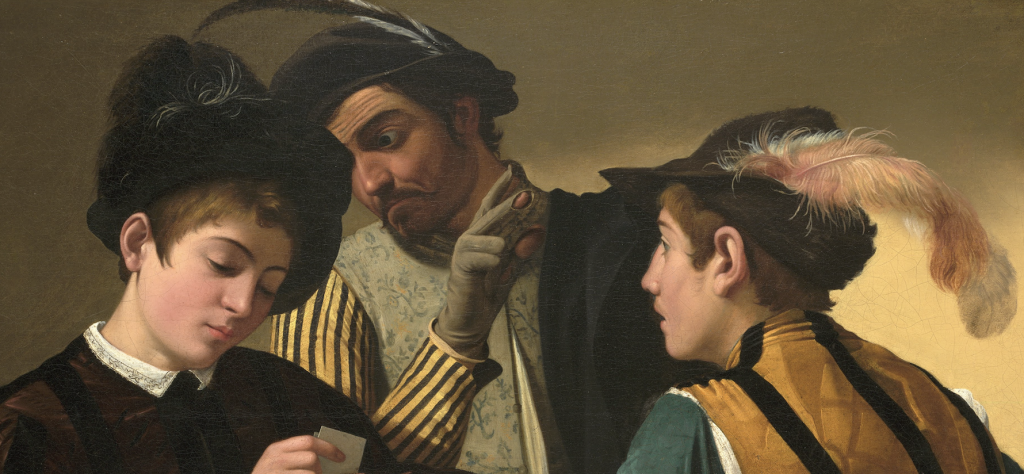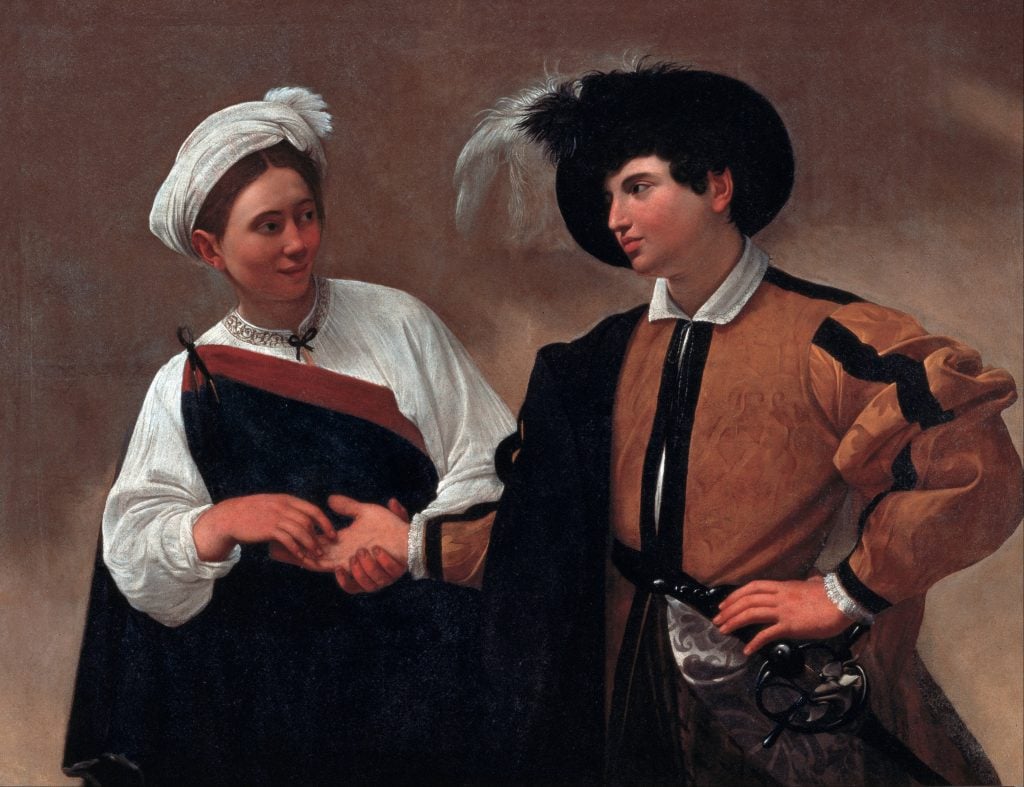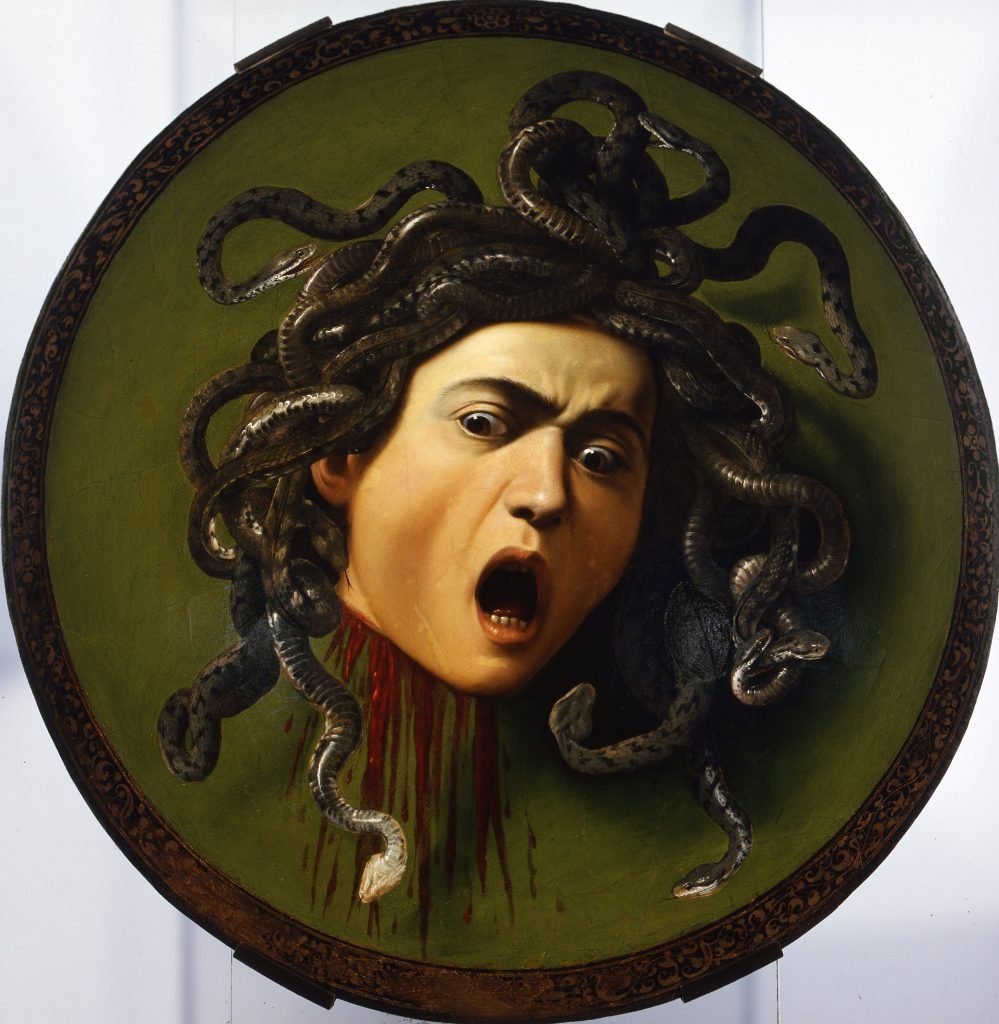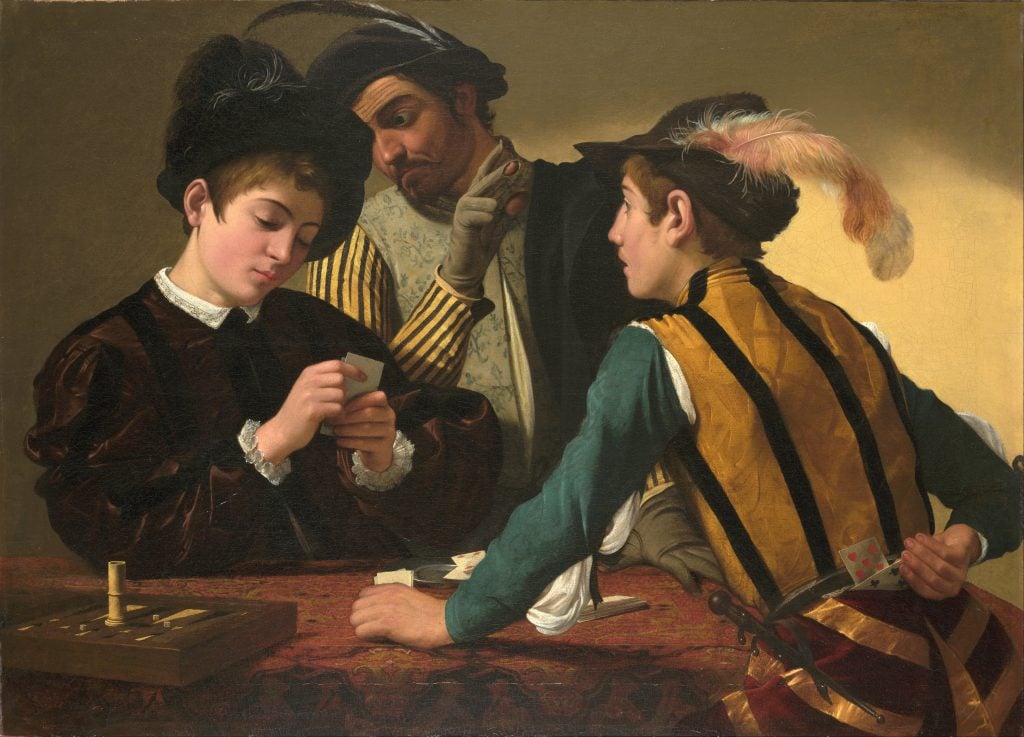In his brilliant, passionate, and all-too-brief life, Caravaggio defined a revelatory Baroque style marked by suspense and realism—not to mention high drama lighting. His daring and direct style shook 16th-century Europe, capturing the attention of popes and patrons, and its influence reverberates to this day.
His works are precious few, however: under 100 paintings are known today, and of those, only 10 works reside within the United States. The new exhibition “Among Friends and Rivals: Caravaggio in Rome” at the Art Institute of Chicago offers the rare occasion to see two of his canvases, The Cardsharps (ca. 1594) and Martha and Mary Magdalene (ca. 1598), together. These intimate depictions are situated in conversation with a selection of works by leading Caravaggisti, the artistic disciples of Caravaggio who embraced elements of his singular style in the decades after his death.
The Cardsharps is considered an early masterpiece by the artist and is on loan from the Kimbell Art Museum in Fort Worth, Texas. The composition shows a foppish and naive well-to-do boy playing a game of primero—a card game that anticipated poker—with another, more wily young man. This second boy is snappily dressed, a pink plume in his hat, but his attire is only a sartorial distraction from his profession—a cardsharp set on duping his mark. At his back, the cardsharp has tucked cards into his belt, which are revealed winkingly to the viewer.
Between the two boys, a grizzled, sinister-looking man looms, peering over the mark’s shoulder, signaling his hand to his youthful accomplice. This seasoned crook wears gloves with slit fingers—a trick that allows him to feel for marked cards. The young cardsharp, one notices, carries a dagger at his hip. Full of theatrical suspense, the work was painted soon after Caravaggio set out on an independent career, having left the workshop of Giuseppe Cesari where he had apprenticed, and selling his works through his dealer, Costantino.
The Cardsharps would significantly influence his nascent career. Cardinal Francesco Maria del Monte, an influential cultural figure, bought The Cardsharps, and perhaps more consequentially, offered the young artist lodgings in his palace, thereby introducing the artist to the elite world that would form his clientele. The painting thereafter had a storied life. It was lost, at one point, for more than 90 years before it was rediscovered, identified by del Monte’s wax seal on its back. Ultimately, it entered the Kimbell’s collection in 1987.
On the rare occasion of the Art Institute’s exhibition, we took a closer look at The Cardsharps and found three facts that might change the way you see it.
1. Here We See the Real Drama of Deception—And a Double Loss of Innocence

Detail of Caravaggio’s The Cardsharps (c.1594). Collection of Kimbell Museum, Fort Worth.
The Cardsharps is a genre painting, a style of painting that depicts scenes of everyday life, but in his work, Caravaggio does away with any overt moralizing about vice. Unlike many artists of his age, who painted using sculptures from antiquity as models, Caravaggio insisted on painting from life, finding his models in all corners of society. This decision was more than just stylistic—rather than understanding painting as a kind of didactic fiction, he believed it should represent everyday realities. The drama of a scene like The Cardsharps, therefore, unfolds through small gestures. Caravaggio frames the composition so that the young cardsharp’s back is to the canvas. We’re privy to the conmen’s sleights of hand, and subtly, we’re invited to adopt their point of view, welcoming us into the grift. The morality of the painting is dubious at best; in the era, paintings of cardsharps were often known as “correctors of fortune,” and it’s hard to deny that in the paused moment of action, we wait with bated breath, hoping the young mark doesn’t realize what’s occurring. The painting is mischievous, the older conman’s face comical in expression, and we feel ourselves rooting, with a bit of a smile, for the bad guys.
The painting is novelistic, offering two possibilities, unfolding on two registers. The cardsharp reaches for a card, but it could, as easily, be his knife that he reaches for. Both boys, from different backgrounds, act as foils and mirrors of one another. But while the wealthy boy’s nails are spotlessly clean, we notice the dirt under the other’s. In one sense the loss of innocence we anticipate is that of the young target, a guileless counterpart about to be duped. But this loss of innocence is doubled. While the rich young boy may lose his money, the young cardsharp, with his body tense, mouth parted in nervous uncertainty, is on the cusp of his own unsavory moment of transformation, and the older, unscrupulous man before him, seems to portend his future.
2. Carvaggio Painted Several Scenes of Swindles—Hinting at the Artist’s Unsavory Predilections

Caravaggio, The Fortune Teller (ca. 1594). Collection of Musei Capitolini, Rome.
The same year Caravaggio painted The Cardsharps he also painted The Fortune Teller, another scene of swindle undercored by class dynamics. The Cardsharps predates The Fortune Teller, and the two compositions share similarities. A well-to-do young man appears, here, in almost comically showy clothing, and stares deeply into the eyes of a Romani girl (identified by her headscarf). She returns his gaze, while reading his palm and slyly removing his ring as she caresses his hand. Caravaggio painted two versions of The Fortune Teller (it is believed he also painted a second version of The Cardsharps), suggesting that he found the subject matter significant.
These two paintings won Caravaggio a fair amount of early acclaim, celebrated for their unusual mixing of high and low—the rough-and-tumble realities of street life with depictions of the elite and with his delicate treatments of fabrics, colors, and adornments. In some ways, the duality of these paintings reflected the artist himself. Caravaggio was known for his wild streak, a gambler and street brawler who frequented unsavory, back alley establishments. Simultaneously, however, he was adored and shielded by the height of Italian society, living a life of great privilege.
Both The Cardsharps and The Fortune Teller proved deeply influential themes. Leading artists including Georges de La Tour, Bartolomeo Manfredi, and dozens of others offered their interpretations on the scenes.
3. The Cardsharps Hints at the Deceptions and Illusion of Painting Itself

Caravaggio, Medusa (1595–1598). Collection of the Uffizi, Florence.
In The Cardsharps, the wealthy young boy stares intently at his cards, unaware of the chicanery that unfolds around him. In some ways, this dandy youth is a metaphor for the viewers of the painting, who imbibe Caravaggio’s painted and illusionistic world without a second thought. Over the years, many have found corollaries between the Baroque artist’s interest in scenes of deception and his realistic approach to painting. In 1603, the poet Gaspare Murtola composed a madrigal referencing, Caravaggio’s Fortune Teller, which suggests that the artist—not the Romani woman he paints—is the truly duplicitous actor, and even calls the artist a “sorcerer.” Caravaggio would take this illusionism even further a few years later with Medusa (1596-98) in which the severed head of the Greek mythical monster is pictured, as though on a platter, with a 3-dimensional quality.
More Trending Stories:
A Secret Room in a 16th-Century Italian Chapel, Where Michelangelo Hid—and Drew—for Months, Opens to the Public
Stuart Semple Unleashes His Final Superblack Paint in His Long-Running Art Supply Battle With Anish Kapoor
This 15th-Century Painting Might Actually Depict a Prehistoric Tool, New Research Suggests
The World’s Most Popular Painter Sent His Followers After Me Because He Didn’t Like a Review of His Work. Here’s What I Learned
A Young Collector Is Launching a New Art Fair in Seoul, Testing a Model He Hopes Will Make a Difference in Asia
A Delayed and Expanded David Hockney Show Opens at London’s National Portrait Gallery, Harry Styles and All
A Nautical Chart Sold at Auction for $239,000 Is Revealed as the 4th Oldest of Its Kind and Is Now Tagged at $7.5 Million












